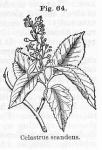 Preparation: Fluid Extract of Celastrus
Preparation: Fluid Extract of Celastrus
The bark of the root and the bark of Celastrus scandens, Linné.
Nat. Ord.—Celastraceae.
COMMON NAMES: Staff-tree, Climbing staff-tree, Staff-vine, False bittersweet, Climbing bittersweet, Waxwork, Fever-twig.
Botanical Source.—This plant is a climbing, indigenous shrub, with a woody, twining stem, without thorns or prickles. The leaves are thin, oblong, acuminate, serrate, alternate, stipulate, petiolate, and smooth; the racemes small, terminal, and axillary; the flowers are greenish-white, or yellowish-white, fragrant, and dioecious. Calyx flat, 5-lobed; corolla spreading, of 5 sessile petals; capsule obtusely 3-angled, 3-celled, and berry-like; valves bearing the partitions on their centers; stamens standing around a glandular, 5-toothed disk; style thick; stigma 3-cleft. The seeds, which are covered with a scarlet aril, number 1 or 2 in each cell (G.—W.).
History.—This plant grows in woods and thickets, from Canada to the Carolinas, creeping on hedges and rocks, or twining about other trees, or each other, and ascending to a great height. It flowers in June and bears a scarlet berry, which remains through the winter. The plant thrives most luxuriously in a rich, damp soil. The root is very long, creeping, woody, of a bright-orange color, about ½ inch in thickness, with a thick red, or yellowish-red bark, which is the medicinal part. On account of the similarity of name, bittersweet, the plant has been confounded with the Solanum Dulcamara, from which, however, it essentially differs in appearance and therapeutic action. The bark has a bitter, afterward sweetish, rather nauseous taste, and imparts its medicinal properties to water.
Description.—The root-bark occurs in nearly smooth quills, orange-brown externally; whitish and marked with fine striae internally. A second layer of an orange-red hue is exposed on the removal of the somewhat tough outer bark. The stem-bark resembles the above, except that its outer layer has an ashen-gray or brownish-gray color.
Chemical Composition.—Wayne (1872) obtained a white crystalline principle to which the name celastrin was given. Bernhard (Amer. Jour. Pharm., 1882, found the bark to contain starch, gum, sugar, coloring material, volatile oil, two resins, one acid and the other neutral, and a body resembling caoutchouc. Mr. Jacob Hoch (1892), failed to find any volatile constituents (A. P. A., 1892). The coloring matter of Celastrus scandens was investigated by Dr. Keller, who defined its chemical relation to the vegetable coloring matters, xanthin and carotin (Amer. Jour. Pharm., 1896).
Action, Medical Uses, and Dosage.—Alterative, diaphoretic, and diuretic, with some narcotic powers. Used in scrofula, secondary syphilis, chronic hepatic affections, cutaneous affections, leucorrhoea, rheumatism, and obstructed menstruation. Externally an ointment has been successfully employed in inflamed and indurated breasts of nurses, in pruritis vulvae, burns, excoriations, etc. Dose of the decoction, from 2 to 4 fluid ounces, 3 times a day; of the extract, from 5 to 10 grains.

